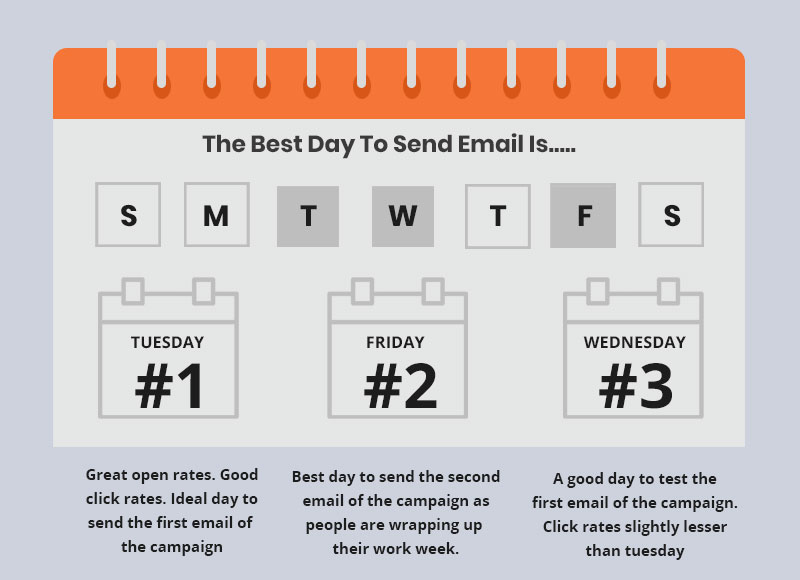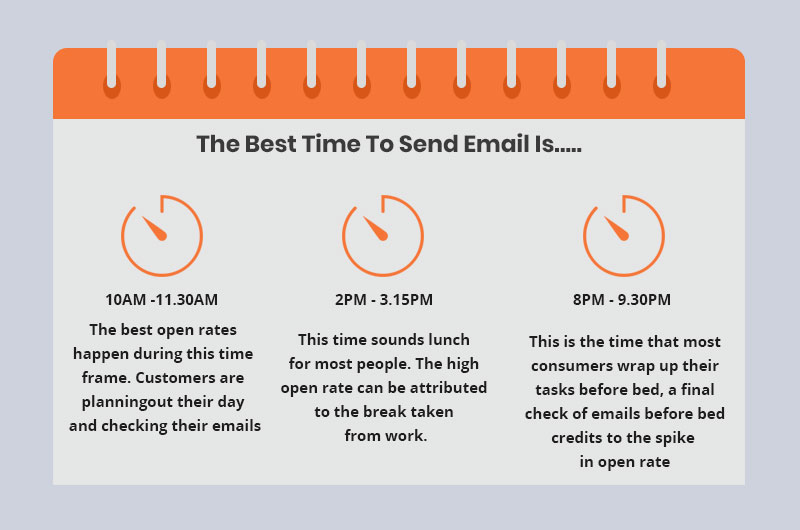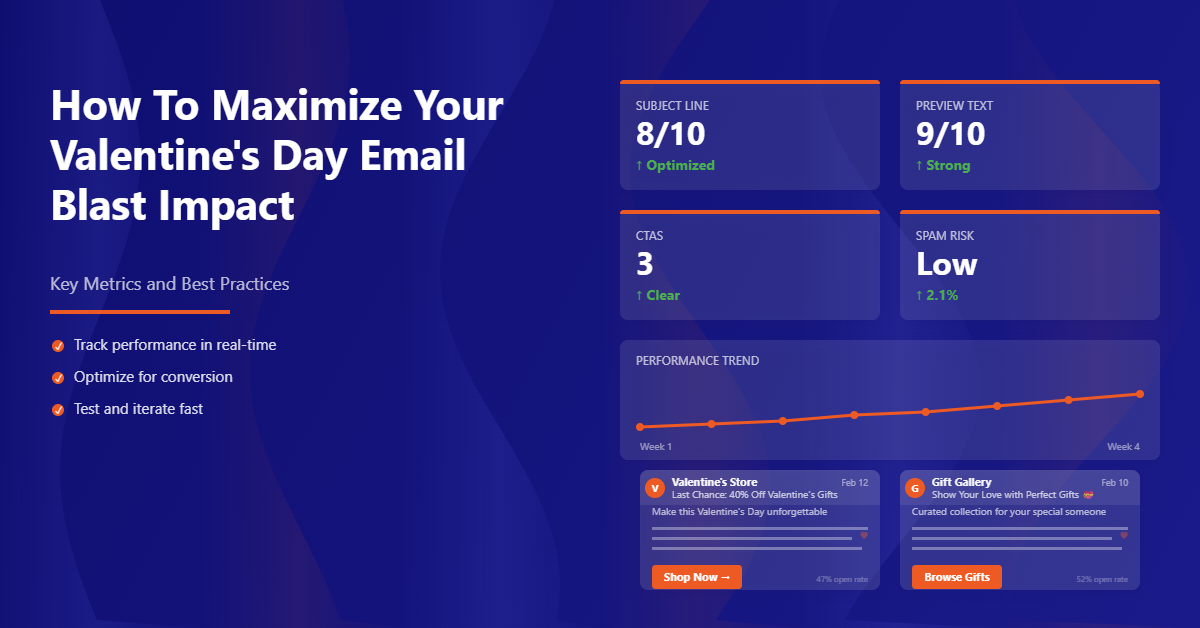If there is ever a competition to find the most frequently asked question related to email marketing, there is one clear, undisputed winner – What is the best time to send emails?
And why not, with over 4 billion active users, 59% of which say that marketing emails influence their purchase decision (Source) – this is a huge marketing channel that one should not miss out on.
Coming to the question, “what is the best time to send emails?”. There are a lot of inconclusive and vague answers on the internet. But with a good reason.
The best time and day to send an email depends on multiple factors, including the nature of the business, type of clientele, the time of year, the campaign type, etc. There is no cookie-cutter answer and to arrive at one, a lot of research and trial is involved.
No time to carry out extensive A/B tests to find the right time for your business? Fret not, we’ve done some of the heavy liftings for you.
We’ve analyzed hundreds of our client’s email campaigns – collecting vast troves of data related to open and click rates to find the most popular times that an email works well. Here’s what we found:
The Best Day to Send Emails
Let’s start with finding the best day to send emails. Our data shows that Tuesdays and Fridays seem to have the most open rates with equally good click rates. Wednesdays came third with similar open rates, but with considerably lesser click rates than the previous two days.
So if you’re just starting out, try sending out the first email of your campaign either on Tuesday or Wednesday with a follow-up email on Friday – just to have a decent interval between different emails.
Weekends aren’t a great choice as it’s usually family time for most people and they tend not to check their emails as much. Email campaigns on Mondays are not a bad choice if sent in the second half of the day. As most people plan out their workweek during the first half and tend not to focus on non-work related emails.
The Best Time to Send Emails
Now that we’ve figured out the best day to send email campaigns, let’s focus on the other important attribute. The best time to send email.
Here are the best timings to send campaigns based on our research:
Use these timings in various permutations and combinations with the day suggestions to find the perfect combination that works for your business.
Another interesting spike in open rates is usually between 6 AM and 8 AM. As more than 17% of Americans check their emails as soon as they wake up.
If you’re curious about click rates, here’s what we found:
Though there were good click rates on other days, these were the ones with the highest conversion rate.
Don’t Miss out on A/B Testing
The aforementioned timings do make for a good starting point. But they can’t be the be-all-end-all formula that guarantees your email campaign’s success.
Sure, these timings will work well for some businesses. But in any case, A/B testing different timings for your email campaigns is strongly recommended.
About 3 in 5 consumers check their emails on their phones. This is a major avenue we should not miss out on. Experiment and send out emails during different times that you know your target audience will be on their phones. Let’s say in the morning, or during lunch or in the evening after work. Try with different days of the week. Is your business email welcomed during the weekend? Try sending out an email and infer from the results.
But remember, no matter how rock-solid your email timing game is, open rates can spike or drop according to the multiple planned and unplanned instances – such as changes in the economy, the season, special occasions, etc. So, be open to tweak and change your email send times in accordance with the situation.
The Line That Impacts Open Rates
… is the subject line.
Over 47% of email recipients open the email based on the subject line alone. (Source).
So it’s imperative that a lot of focus and forethought goes behind the writing of this line.
The first attribute to focus on is the length of the line. Research shows that shorter subject lines work better. The ideal length for subject lines is around 41 characters or 4 words. Here’s the data:
Experiment with different tones in the subject line. Subject lines can be direct, funny or may also have an element of intrigue. Emojis are excessively used in subject lines these days and are a great way to set your email apart. Discount codes are always a winner, adding them to your subject line will see a definite hike in the open rate.
Image with an intriguing subject line “ We know you’ve been eyeing this….”
Email Writing – Best Practices
Content
You may think that the actual contents of an email do not have an impact on the open rate. But that’s not true.
The best way to keep people responding to future email campaigns is by providing quality content. You don’t want to disappoint your customers or lose them because the email content was not readable, or the CTA didn’t work or maybe the template wasn’t responsive on their device. All these have an adverse impact on both the future open rates as well as the brand image.
Focus on the content. Ensure that it has the right flow and is grammatically sound. Don’t hesitate to proof-read your copy twice. Customers love crisp and clean content. Experiment with how you would like your brand to be perceived. Change up the tone and see if your subscribers like it. One very important takeaway is to focus on the choice of words. Ensure that the words used to not trigger spam filters. That would be a bad blow to the entire campaign and is a black mark to the brand’s credibility.
Images
A picture speaks a thousand words, right? Absolutely true in the sense of email marketing.
An email has to grasp the reader’s attention in the first couple of seconds in order to make them read the body content.
Using a standard color theme through all your email campaigns is great for brand recognition. Add eye-catching images, play around with gifs, with one important thing in mind – the loading speed.
It’s no secret that slow-loading pages put customers off, and it’s the same in the case of emails. Not to mention that image-heavy emails tend to have a higher bounce rate and/or trigger spam filters. So create great imagery, but also proceed with caution.
Templates
Templates are a great way to create emails easily. Just choose one of the preformatted templates, plug in your images and content, you’re ready to go.
One of the important points to take into consideration is the responsiveness. Over 47% of consumers check their emails on a mobile device (Source). So ensure that the email checks well on mobile.
A final check of the links, CTAs, and contact details – your email is ready to go.
Need help with finding the right template? TargetBay offers great responsive templates, that can be tweaked to suit every business need.
Building and Maintaining Email Lists
The success of an email campaign rests on the state of the email list. There are two major attributes to focus on
1) Adding new data to the email list
2) Maintaining the health of the email list
Capturing new data
New leads equal new prospects. This is no rocket science. It’s important to keep adding to your list in order to grow your business and keep the list fresh.
Pop-ups are a sure shot way to gain new email ids. Add them to your homepage, in the case of exit-intents, add some discount codes in the mix. Pop-ups definitely work and get the job done.
Create hooks. Share exclusive content such as ebooks and infographics with subscribers. Newsletters work great as well. Promote your newsletter and encourage subscription throughout your site.
Leverage the power of social media. Running ads on Facebook may involve a budget, but it’s surely worth the result.
Maintaining the email list
A healthy email list is an engaged email list. And an engaged email list is the heartbeat of any successful email campaign.
Start early. Send welcome emails to the new subscribers. Assure them of the quality content that they signed up for.
Remove inactive users, duplicates, incorrect entries from the list. You don’t want duds to mess your campaign’s actual success rate. Also, ensure that you have a working “unsubscribe” link in your email footer. Losing customers by unsubscribing is better than to be reported as spam.
Final Notes
Now that we’ve shared what works for our top customers, we hope that it has reduced at least some of the guesswork involved in your campaigns. But please remember, behind every successful email marketing campaign, is a lot of patience and a whole ton of A/B testing.
Do you have a rock-solid email timing that works amazing for your business and brings in conversions? Let us know in the comments!









